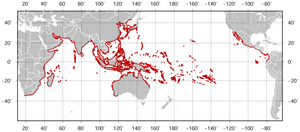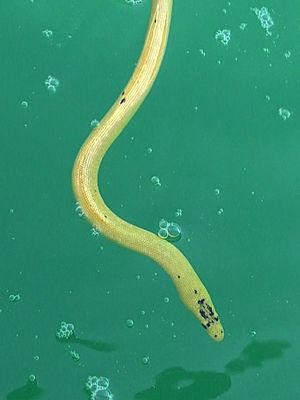Yellow-bellied sea snake facts for kids
Quick facts for kids Yellow-bellied sea snake |
|
|---|---|
 |
|
| Yellow-bellied sea snake | |
| Conservation status | |
| Scientific classification | |
| Genus: |
Hydrophis
|
| Species: |
platurus
|
 |
|
| Yellow-bellied sea snake range | |
| Synonyms | |
|
List
Anguis platura Linnaeus, 1766
Hydrus bicolor Schneider, 1799 Hydrophis platura – Latreille, 1801 Pelamis platuros – Daudin, 1803 Pelamis bicolor – Daudin, 1803 Hydrophis pelamis Schlegel, 1837 Pelamis ornata Gray, 1842 Pelamis platurus – Stoliczka, 1872 Hydrus platurus – Boulenger, 1890 Pelamydrus platurus – Schmidt & Davis, 1941 Pelamis platura – Böhme, 2003 |
|
The yellow-bellied sea snake (Hydrophis platurus) is a type of snake that lives in the ocean. It is a venomous snake found in warm, tropical waters all over the world, except for the Atlantic Ocean. For a long time, it was thought to be the only snake in its own group, called Pelamis. But new scientific studies show it belongs with other snakes in the group Hydrophis.
Contents
About the Yellow-Bellied Sea Snake's Name
In 1766, a famous scientist named Linnaeus first described this snake. He called it Anguis platura. Later, in 1803, another scientist named François Marie Daudin gave it a new group name, Pelamis. He called the snake Pelamis platuros.
The name Pelamis comes from an old Greek word for "tunny fish," which is a type of tuna. This might be because of where the snake lives or what scientists thought it ate. The second part of its name, platurus, means "flat tail" in old Greek. This describes its flat, paddle-like tail.
Scientists are still working to figure out the best way to name and group sea snakes. This is why you might see different scientific names for the yellow-bellied sea snake. Other common names for it are yellowbelly sea snake or pelagic sea snake.
How Sea Snakes Evolved
Sea snakes are a special group of snakes that came from venomous land snakes in Australasia (like cobras and taipans). This happened about 10 million years ago. The yellow-bellied sea snake is part of a group called Hydrophis, which has many different kinds of sea snakes.
What the Yellow-Bellied Sea Snake Looks Like

As its name suggests, the yellow-bellied sea snake has a clear two-color pattern. It has a yellow belly and a brown or black back. This makes it easy to tell apart from other sea snakes.
Yellow-bellied sea snakes are fully adapted to live their entire lives in the ocean. They mate, eat, and give birth to live young at sea. They have special features that help them in the water. Their bodies are flattened from side to side, and their tails are like paddles for swimming. They can close their nostrils to keep water out. They can also breathe through their skin while underwater, getting up to 33% of the oxygen they need!
Sea snakes also have a special gland in their lower jaw. Scientists used to think this gland helped them get rid of salt from seawater. However, it's now known that sea snakes only drink fresh water, usually from rain that collects on the ocean surface.
Body Features
This snake has a body that is flattened, especially towards the tail. Its scales are small and fit closely together. The head is narrow with a long snout.
The colors of the snake can vary, but most are clearly two-toned: black on top and yellow or brown underneath. The two colors are usually very distinct. Sometimes, there are black spots or bars on the yellow belly. In some snakes, the yellow color might extend higher up, leaving only a thin black stripe down the middle of the back.
Male yellow-bellied sea snakes can grow up to 720 mm (28 in) long. Females can be a bit longer, up to 880 mm (35 in). Their tails are relatively short.
Where Yellow-Bellied Sea Snakes Live
The yellow-bellied sea snake lives in more places than almost any other snake in the world. It lives completely in the open ocean. You can often see them floating along ocean currents and using storms to travel across the sea. Their homes are mostly decided by warm water temperatures and ocean currents.
These snakes are found all across the warm parts of the Indo-Pacific Ocean. They also reach places like Costa Rica, southern California, and northern Peru. They are the only sea snake that has made it to the Hawaiian Islands. They like to hunt and have babies near floating mats of sea kelp in the Indian Ocean.
Sometimes, these snakes are found in colder places like the coasts of southern California, Tasmania, and New Zealand. New Zealand usually doesn't have snakes, but the yellow-bellied sea snake sometimes visits. These visits to colder waters often happen during El Niño events or big storms. They need water that is at least 16–18 °C (60.8 to 64.4 °F) to survive for a long time.
The yellow-bellied sea snake is the only sea snake that has been found in the Atlantic Ocean. However, these sightings are rare and not considered part of their natural home. They likely got there by accident, perhaps carried by currents or human activity.
For example, they have been seen in the Caribbean Sea near Colombia a few times. Scientists believe this is because of human activity, like being carried by ships or perhaps even through the Panama Canal. The Panama Canal is made of fresh water, which makes it hard for sea snakes to cross. Also, the land bridge between North and South America has kept them from naturally moving into the Caribbean Sea from the Pacific Ocean.
Yellow-Bellied Sea Snake Behavior and Reproduction
Contrary to what people once thought, sea snakes need fresh water to live. The yellow-bellied sea snake drinks rainwater that collects on the surface of the ocean. These snakes can survive very long periods without water, sometimes up to 7 months during dry seasons.
Yellow-bellied sea snakes have their babies in warm waters. They give birth to live young, meaning the babies hatch inside the mother and are born alive. The pregnancy lasts about 6 months. They are not very good at moving on land because their belly scales are small and form a ridge.
Sometimes, thousands of these snakes gather together on the surface of the water in large groups. Scientists think they do this to help them catch food. They hunt by floating on the surface to attract small fish looking for shelter. When a fish comes close, the snake swims backward quickly and lunges to catch it. Being able to swim backward is a very unusual and special ability for this snake!
Yellow-Bellied Sea Snake Venom
The venom of the yellow-bellied sea snake is very strong, just like the venom of other sea snakes. A very small amount of its venom can be dangerous.
Antivenom for Bites
Sea snake venom can harm muscles and kidneys. If someone is bitten by a yellow-bellied sea snake, doctors can use a special medicine called antivenom. An antivenom made for the Enhydrina schistosa sea snake works well against the yellow-bellied sea snake's venom. If that specific antivenom isn't available, other antivenoms for snakes like the tiger snake can be used. Luckily, no deaths have been reported from bites in Australian waters.
Other Information
- Ditmars, R.L. 1936. The Reptiles of North America. Doubleday, Doran & Co. New York.
- Kropach, C. 1975 The yellow-bellied sea snake, Pelamis, in the eastern Pacific. pp. 185–213 in: Dunson, W., ed., The Biology of Sea Snakes. Univ. Park Press, Baltimore.
- Smith, M.A. 1943. The Fauna of British India, Ceylon and Burma, including the Whole of the Indo-Chinese Sub-region. Reptiles and Amphibians. Vol. III. – Serpentes. Taylor & Francis. London.
See also
 In Spanish: Serpiente marina amarilla para niños
In Spanish: Serpiente marina amarilla para niños



